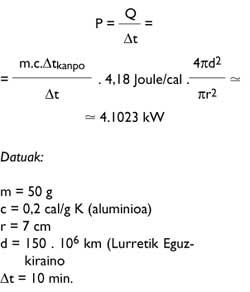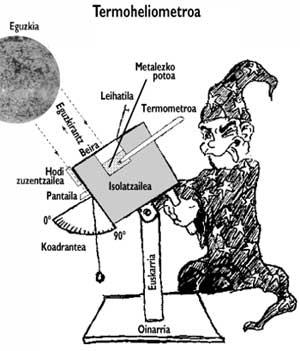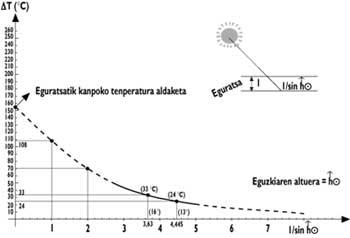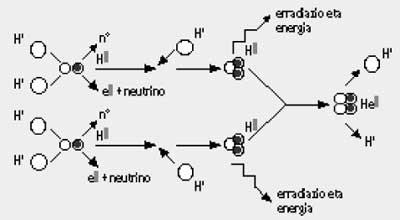Fundamentals of practical astrophysics (and II): measuring solar energy
For this purpose we will use the TERMOHELIOMETRO. Its function is to measure the heat exchange that occurs when a hot focus, such as the Sun, heats an object, a tin of metallic drink.

It will not be difficult to obtain the material necessary for the realization of the thermoheliometer: the bottom of a can of drinks, a thermometer, a closed box in which we will keep all this, the support and a system of axes with screws to direct everything towards the Sun. To this system we will apply a quadrant and a small corrector tube that will give us the height of the Sun.
Once all this is done, the steps detailed below will be taken. First, we will head the metal towards the Sun and measure the temperature change in a certain period of time (it can be enough in 10 minutes) and at different heights of the Sun. We will repeat the process itself five times an hour and reflect on a graph the data obtained, that is, the temperature variation of the thermoheliometer and the height of the Sun. Based on them and by extrapolation, we will calculate without any type of carpentry the maximum temperature change we measure outside the atmosphere.

As the heat that loses the Sun is part of the one that occupies the metal, we can calculate the total heat of the Sun. The next logical step is to calculate the power in a given time. The value we get is called CONSTANT SUN. With the measurements we can foresee an approximate value of 4 x 10 26 watts.
How long does it shine?

But we have only answered one of the questions we have asked at the beginning. How is the production process carried out? How long will the Sun last in those conditions of brightness? To answer these questions, we should consider the active mass of the Sun (burning, fuel) and the different combustion systems (chemical, cooling, gravity, contraction or nuclear).
The mass of the Sun is 2 x 10 30 kg (this data does not have to be learned from memory). The distance from the Earth to the Sun is 150 million kilometers and we know that the period of rotation of the Earth with respect to the Sun is one year, with this data and using the Law of Universal Gravitation we can calculate the mass). Despite this solar mass, the nuclear combustion system only requires 10%, since the temperature capable of producing nuclear reactions only occurs in the nucleus. In the rest of the cases, a total mass can be taken.

When the energy source is nuclear,
E (nuclear) = m c 2
Apply the formula
If we consider that the energy source is chemical, there are two possibilities: one, that the fuel is coal and another, that the hydrogen. In both cases, the combustion heat has the same value:
Q(C) = 13 x 10 7 J.kg –1
In this case, the total energy is multipliced by mass. In the event that the energy source is cooling, the temperature change will be taken (from 6,000 to 0 K), the heat capacity (C(H 2) = 14 x 10 3 J/kg K) and the mass, obtaining the total energy by multiplying the three factors.
The total energy that would be emitted by gravity or contraction will be calculated by applying the following formula:
E (issued) = 3/5. G. G. M 2 /R.

In the case of the nuclear process, 10% of the mass of hydrogen produces helium with a yield of 0.7%. The lost mass is transformed into energy by Einstein's equation.
In the table above, the energy obtained in each process is detailed. With this and with the speed of energy emission that we have calculated in our experiment, that is, with the power, you can foresee the years in which the Sun would shine.
Geological measurements are also adequate instruments to reach these conclusions. For example, measuring the mineral wealth of the radioactive isotope uranium-238, we can affirm that the Earth is 4.8 billion years old and that, therefore, its star Sun is 5,000 million years old. As it is expected that the Sun will remain the same time as its age, we can give the source of nuclear reaction good.
How is the heat of the Sun?

As mentioned above, the temperature of the Solar Core should be 10 million degrees to be fused with a quad-core hydrogen helium. And now you ask me, where have you removed those 6,000 K from the photosphere? We have said it before, but remember again, in its spectrum the most intense colors give us the surface temperature of a compact and hot object that energy radiation.
You are right to the reader, all that can be difficult to measure with our humble spectroscope (but I promise you I have confirmed it myself! ). However, we can use the law of Stefan Boltzman, in which the surface temperature of the focus, its size and the total power emitted is related experimentally, using the following equation:

We have measured the power emitted by the Sun (P) through the thermoheliometer, and using the geometric methods offered by the astronomy of Position, we have determined the size of the Sun and hence S, we have calculated the surface; if you use these data correctly, the surface temperature of the photosphere will be 5.800 K.
First step on the road
So far we just have to do Heliophysics and you have to give the reason! However, we have already taken the first step and are now able to measure and classify the color, brightness and distance of other stars. Once this is done, we could start looking for another “key” to find the birth, life and death of stars: R.U. diagram. And from there we can go to know our Milky Way or the whole Universe... This is a requirement too large to be carried out on the last lines of this article. So for the following we have to count.





